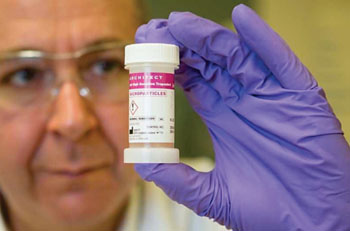Blood Test Rapidly Identifies Low Risk of Cardiac Event
By LabMedica International staff writers
Posted on 21 Oct 2015
A test that measures blood for the cardiac troponin protein, which is released by damaged heart cells, may help doctors rule out heart attack faster in patients with similar symptoms.Posted on 21 Oct 2015
Suspected acute coronary syndrome is the most common reason for emergency admission to hospital and is a large burden on health-care resources and strategies to identify low-risk patients suitable for immediate discharge would have major benefits.

Image: The ARCHITECTSTAT troponin I assay (Photo courtesy of Abbott Laboratories).
Medical scientists at the University of Edinburgh (UK) consecutively enrolled 6,304 patients with suspected acute coronary syndrome presenting to four secondary and tertiary care hospitals in Scotland in a prospective cohort study. They assessed the threshold of cardiac troponin in two independent validation cohorts. The first validation cohort included 1,126 consecutively enrolled patients with suspected acute coronary syndrome and the second included 308 consecutively enrolled patients at a different medical center.
As standard of care, a sensitive cardiac troponin I assay (ARCHITECTSTAT troponin I assay; Abbott Laboratories, Abbott Park, IL, USA) was used for clinical decision making and the result declared to the patients' clinicians. The assay has a limit of detection of 1.2 ng/L, and an upper reference limit (99th centile) of 34 ng/L in men and 16 ng/L in women. In derivation and validation cohorts, they evaluated the negative predictive value of a range of troponin concentrations for the primary outcome of index myocardial infarction, or subsequent myocardial infarction or cardiac death at 30 days.
The investigators found that 782 of 4,870 (16%) patients in the derivation cohort had index myocardial infarction, with a further 32 (1%) re-presenting with myocardial infarction and 75 (2%) cardiac deaths at 30 days. In patients without myocardial infarction at presentation, troponin concentrations were less than 5 ng/L in 2,311 of 3,799 (61%) patients, with a negative predictive value of 99.6% for the primary outcome. In two independent validation cohorts, troponin concentrations were less than 5 ng/L in 594 of 1,061 (56%) patients, with an overall negative predictive value of 99.4%. At one year, these patients had a lower risk of myocardial infarction and cardiac death than did those with a troponin concentration of 5 ng/L or more.
The authors concluded that low plasma troponin concentrations identified two-thirds of patients at very low risk of cardiac events who could be discharged from hospital. Implementation of this approach could substantially reduce hospital admissions and have major benefits for both patients and health-care providers. The study was published on October 7, 2015, in the journal the Lancet.
Related Links:
University of Edinburgh
Abbott Laboratories













